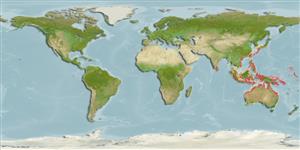Teleostei (teleosts) >
Gobiiformes (Gobies) >
Gobiidae (Gobies) > Gobiinae
Eponymy: Dr George Sprague Myers (1905–1985), an American ichthyologist, bio-geographer and herpetologist, was Professor Emeritus of Biological Sciences at Stanford, California. [...] (Ref. 128868), visit book page.
Environment: milieu / climate zone / depth range / distribution range
Ecology
Marine; demersal; depth range 2 - 20 m (Ref. 90102). Subtropical
Western Pacific: Japan to Australia.
Size / Weight / Age
Maturity: Lm ? range ? - ? cm
Max length : 10.0 cm SL male/unsexed; (Ref. 48637)
Dorsal spines (total): 6 - 7; Dorsal soft rays (total): 10; Anal spines: 1; Anal soft rays: 9. Characterized by overall whitish or pale grey to yellow body color; dark brown to blackish stripe from eye to middle of caudal fin base; head with orange to bluish spots; fins mainly pale and unmarked; first dorsal fin much taller than second dorsal fin; united pelvic fins, frenum present; longitudinal scale series 90-95; head without scales; greatest depth of body4.5-5.0 in SL; rounded caudal fin, about equal to head length (Ref. 90102).
Lives in muddy coastal bays and estuaries (Ref. 48637). Also found in sheltered bays and lagoons in 2-20 m (Ref 90102).
Life cycle and mating behavior
Maturity | Reproduction | Spawning | Eggs | Fecundity | Larvae
Masuda, H., K. Amaoka, C. Araga, T. Uyeno and T. Yoshino, 1984. The fishes of the Japanese Archipelago. Vol. 1. Tokai University Press, Tokyo, Japan. 437 p. (text). (Ref. 559)
IUCN Red List Status (Ref. 130435: Version 2024-1)
Threat to humans
Harmless
Human uses
Tools
Special reports
Download XML
Internet sources
Estimates based on models
Preferred temperature (Ref.
123201): 24.9 - 29.3, mean 28.6 °C (based on 2191 cells).
Phylogenetic diversity index (Ref.
82804): PD
50 = 0.5020 [Uniqueness, from 0.5 = low to 2.0 = high].
Bayesian length-weight: a=0.00724 (0.00339 - 0.01546), b=3.10 (2.92 - 3.28), in cm total length, based on LWR estimates for this (Sub)family-body shape (Ref.
93245).
Trophic level (Ref.
69278): 3.4 ±0.4 se; based on size and trophs of closest relatives
Resilience (Ref.
120179): High, minimum population doubling time less than 15 months (Preliminary K or Fecundity.).
Fishing Vulnerability (Ref.
59153): Low vulnerability (10 of 100).
